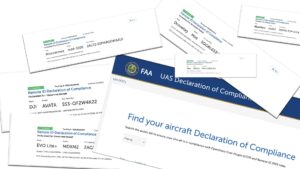2023 FAA Symposium Recap, Day 1
Day of the the FAA Drone Symposium is in the books.
Overall a mixed bag.
The not-so-good.
There was a lot of talk about data during the sessions I went to today. The FAA needs data. Which I certainly get. Data drive safety cases, and the FAA is all about safety. The airspace is the safety in the world, all while having some of the most congested and confusing airspace in the world. Think SoCal or the NYC/NJ corridors. Crazy busy.
And we can thank the fine folks at the FAA for this history of safety.
But we’re talking about drones, not manned aircraft.
Data is good, and is needed. But that data exists. But the FAA isn’t asking the right people for it. There are millions upon millions of sUAS flights on record in the US. And the vast majority of that is verifiable thanks to flight records of most drone manufactures. Yes, it’s unlikely many folks would share their flights records with the FAA, but it still exists.
Many in the sUAS community accuse the FAA of clearing the skies for the big money companies like Amazon and UPS Flight Forward. They accuse the FAA of taking money from those companies and kicking the small DPS out of the sky for the large companies benefit.
Having worked with the FAA and all of the large delivery companies on numerous committees and work groups, I can promise you that isn’t the truth. The FAA vehemently denies this accession, and the large UAS companies complain about the procedures and methodology required of them by the FAA.
It just isn’t happening. Either that, or I’m the most clueless and naive person in the rooms during those discussions. And I just don’t think that’s true.
And think about it, if this was true, the US would be leading the world in AAM and UAS delivery testing instead of falling so tragically behind many countries who are testing these systems already.
Having said that, based on the direction of so many of the panels today, I can see why folks think this. The panels do seem to discuss things from a AAM/UTM perspective. The small time operator doesn’t seem to be part of the discussion very often.
Back to data…
I’m not sure I sat in a panel today where the word “data” wasn’t said at least a dozen times. “We need data…”, or “We’re analyzing the data…”, or “We need to decided what data we need…”.
Yes, all well and good, but the “data” talked about was from folks who run (or are working on the regulations for) long range BLVOS and other complex operations, for which rapid scalability is necessary for success. Yes, 100% we need that data for those operations to scale and be a success.
And with their success comes success for many other smaller scale DSP operations. Large scale, more complex missions do benefit the smaller operators.
But when is that going to happen? We’ve been hearing these same needs and wants for “data” for the last two or three years.
It’s time to do, not time to decide what needs to be done.
As of 8/1/23, there are 342,544 Remote Pilots listed in the FAA’s Active Airmen Registry. Let’s say conservatively that 2% of those Remote Pilots are actively working in the long range BVLOS verticals, or in verticals that would benefit immensely from long range BVLOS. That’s approximately 7,000 Remote Pilots that will benefit from what the FAA seems to focused on getting regulations out for.
Again, fine and dandy for the industry. We need that, there is no reasonable argument against that.
But what about the 335,000+ other Remote Pilots that would benefit from eVLOS (extended VLOS of <3SM or less)? Think of the 100s (1000s?) of those types of flights that take place every day. And take place with virtually a 100% safety rating.
If we want to be serious about advancing the sUAS industry in this county, we need to get these operations approved and legal. How about we push that out now?
The FAA wants data? I’m more willing to give them my data that shows me flying a P4PV2 out 2300’ at 300’ AGL. All with absolute command of the airspace, as well as virtual certainty of not flying over people. Or how about flying my Mavic 3 Pro 1500’ out (my VO can still see it, and I have command of the airspace) for a video shoot chasing construction equipment?

Okay, how about the good from Day 1? I don’t want you readers to think it was a complete bummer in Baltimore today.
The good deals with Remote ID. No, it really does. Not RID itself mind you, but the read of the room, or more specifically my read some on the panelists.
I have no inside information (as much as I’m dying to have it), so what I’m going to write is pure conjecture on my part. Possibly educated conjecture, but also possible overly optimist and Pollyannish conjecture on my part.
I guess we’ll find out the middle of next month.
First of all, the FAA folks on the panel got more than just a little bit of feedback at the session titled, “Coming Soon! Remote ID Operational Compliance. Ready?” The room actually got a little raucous towards the end of the panel discussion. And the FAA folks on the panel emphasized more than once that they were there to listen to the feedback. And I have no doubt in my mind they truly were. I agree with all the feedback, and commiserated with the commenters (I kept my mouth shut), but I honestly think the FAA folks were there to listen.
And it seemed to me that there was more than one instance of those “in the know” sharing furtive glances when questions like compliance and deadline extensions were mentioned. There was even a remark or two about issues. They know about module supply issues. They know that some companies (hello DJI) aren’t able to get RID compliance firmware updates out in time for the September 16 deadline.
They even admitted the ”FAA acknowledges shortages of RID Modules. There will probably be some announcements before the deadlines. All things are on the table.”
So what is on the table? Delay in enforcement? Deferred enforcement for those trying to comply?
They also admitted that just because an RID app does’t pick up the RID message from the drone or module doesn’t mean the operator isn’t in compliance. It just means the app or receiver isn’t working.
So how will LEOs know if the drone they’ve been called out on is compliant or if their RID app doesn’t work? Will the LEOs get guidance from the FAA about how to handle these issues? Will the FAA educate LEOs about the intricacies of RID and it’s reception issues?
I have no crystal ball, and honestly if I did, I wouldn’t be asking about RID deadlines. But I honestly think there is something in the works that will satisfy some of the concerns about RID and the upcoming possible poo-poo platter being served to the sUAS communities.
I was even able to bring up my idea about “RID On A Stick” for FPV races and events. The person I talked to (I won’t name names) thought it was a good idea. For FPV events that is perfect way to satisfy the intent of the law. Simply have a single RID transmitter placed near the pilot table, and presto, done.
Well, there are two more days of this, so I’ll post about today’s sessions tonight. This afternoon the FAA Drone Symposium switches gears and becomes the AAM Summit. Not really my area of expertise, but maybe I’ll learn a thing or two?
____________________________________________________________________________
Drone Service Providers Alliance provides “Professional advocacy for Drone Service Providers throughout the United States”. Our mission statement is “A United Voice for Positive Change”. We are a dues supported 501(c)(6) organization. Dues are used to cover travel and operating expenses. No salaries are taken by Kenji and Vic for the work they do on behalf of the US UAS industry. We fully believe a rising tide raises all boats. And since we also fly drones for a living, it will benefit us as well.
If you believe in what we do, please consider joining us, we appreciate any and all support: https://dspalliance.org/join-us/
Also, have you added to your drone fleet? Do you know the ins and outs of your new drone? Check out Pilot Institute’s Deep Dive Videos. Greg and crew do an great job helping you understand your drone better. And each and every Deep Dive Video is free.
Also, if you don’t have your 107 yet, or are looking to add UAS Verticals, check out the Pilot Institute site for additional classes. They have business classes, a VO class (pay for your VOs to take it), mapping, photography, and more. Check out their offerings here!
Need a new drone? Need to rent one for a specific job? Need some repair work done? Blue Sky Drones is your answer to all of these questions.
And as always FLY SAFE!



